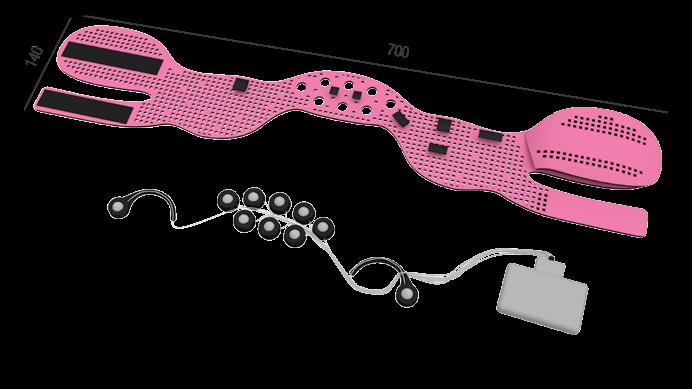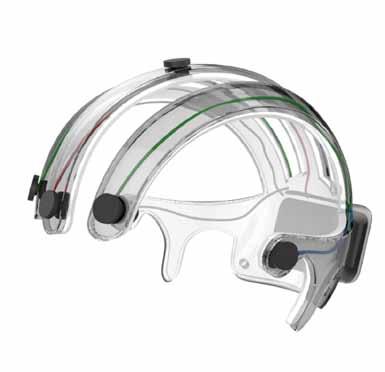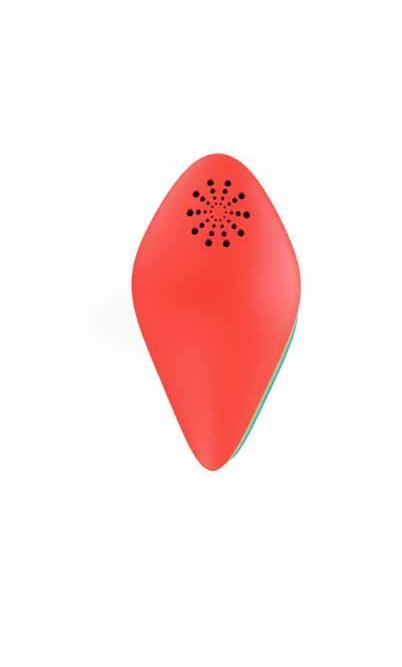
5 minute read
Leggere l’empatia
Progetto di tesi/Thesis project con/with Brainsigns
Relatore/Advisor: Marika Aakesson Prototipazione/Prototyping: Mauro del Santo, Francesco Pizzo Comunicazione/Communication: Alessio Tommasetti
Advertisement
Leggere nella mente umana ha sempre affascinato l’uomo: gli esempi nella letteratura, nella musica, nel cinema e nella storia sono tanti e spesso circondati da misticismo, oppure legati alla fantascienza. La neuroscienza cognitiva e comportamentale oggi è in grado letteralmente di leggere i segnali del cervello e con l’utilizzo di algoritmi che combinano questi segnali ad altri parametri vitali riesce a trarre conclusioni legate al livello di attenzione, di impegno cognitivo o allo stato emozionale di una persona. La neuroscienza può essere usata come strumento di indagine, non per la manipolazione dell’individuo, ma piuttosto il contrario: per dare attenzione all’anima e capire meglio che cosa la persona trova difficile o facile, noioso o divertente, inutile o interessante, brutto o bello. Il progetto di tesi sviluppato con Brainsigns parte dal presupposto che scoprire lo Human Factor (il missing link nella catena dell’IoE, Internet of Everything) e conoscerlo potrebbe aumentare il comfort e la sicurezza dell’individuo, aiutare le aziende a rendere più user-friendly i loro prodotti, migliorare l’adattamento dell’automazione alle esigenze delle persone. Brainsigns è una spin-off company dell’Università La Sapienza di Roma che sviluppa innovazione a partire dalla conoscenza scientifica nella registrazione e nell’analisi di segnali prodotti dal funzionamento del cervello all’interno di diverse aree di ricerca come: Neuromarketing, Human Factors e Applicazioni Cliniche. Agli studenti è stato chiesto di sviluppare una ricerca e progettare un headset, per uno dei seguenti ambiti: - la formazione di piloti, con l’obiettivo di monitorare il sovraccarico di stress e migliorare le prestazioni e i tempi di training; - i test di Neuromarketing, da utilizzare nell’esecuzione di testing di percezione, usabilità, esperienza di prodotto e packaging; - il benessere, con l’obiettivo di individuare nuovi campi di applicazione della neuroscienza per proteggere la salute e aiutare la disabilità. Durante la progettazione gli studenti hanno utilizzato gli strumenti di prototipazione rapida per la realizzazione di modelli di studio e prototipi in modo di potere verificare in tempo reale che le loro idee corrispondessero ai requisiti chiesti dall’azienda: facile da indossare, confortevole durante l’utilizzo, innovativo nei materiali e nella forma, personalizzabile sia nelle dimensioni che nell’estetica, riproducibile in piccole quantità utilizzando rapid prototyping. Alla fine sono stati selezionati i 6 headsets ritenuti migliori nelle prestazioni e sono stati presentati all’azienda Brainsigns. È stato selezionato, acquistato e brevettato l’headset progettato da Francesco Della Monaca La scelta è stata determinata dalla facilità con cui si indossa l’headset: il gesto per indossarlo assomiglia a quello che si usa fare per un paio di occhiali da sole e l’adattabilità alla testa è garantita dall’utilizzo di un materiale elastomero termoplastico simile alla gomma.

Stefano Pellino, Headset futuristico per gli allievi della Scuola di Volo dell’Urbe. Materiale: PA Nylon Tecnologia: stampa 3D A futuristic style headset for Urbe flight school students. Material: PA Nylon. Technologies: 3D printing

Francesco Della Monaca, Headset per neuromarketing dalla facile indossabilità / Easy-to-wear headset for neuromarketing Materiale/Material: TPU thermoplastic polyurethane Tecnologie/Technologies: 3D printing Il progetto è stato selezionato dall’azienda partner Brainsigns che ne ha depositato il brevetto The project has been selected by the partner company Brainsigns, which also has patented the headset.

Gabriele Nappi, Headset per l’addestramento sportivo studiato per essere indossato mentre si è in movimento A sports training headset designed to be worn while on the move. Materiale/Material: Yulex Pure™. Tecnologie/ Technologies: taglio laser / laser cutting


Agnese Roviti, Headset unisex per il Neuromarketing. Il progetto indaga i condizionamenti della pubblicità e come la neuroscienza potrebbe aiutare l’individuo a trovare se stesso/ A unisex headset for Neuromarketing. In her research Agnese explored how advertising influenced the mass and how neuroscience could help the individual find himself. Materiale / Material: Yulex Pure™. Tecnologia / Technology: taglio laser/ laser cut



Giulia Verticchio, Headset per persone affette da afasia. L’headset aiuta la persona a comunicare con altre persone utilizzando un software capace di trasformare gli impulsi registrati in suoni e parole/ A headset for people with aphasia. The headset helps the person to communicate with other people using software that transforms impulses recorded in sounds and words. Materiale / Material: PLA. Tecnologie / Technology: stampa 3D / 3D printing


Marlene Aschettino. Headset unisex e futuristico per gli allievi della scuola di volo. Materiale principale: PA Nylon e Yulex Pure™ Tecnologie: stampa 3D e taglio laser A unisex and futuristic style headset for Urbe flight school students. Main material: PA Nylon and Yulex Pure ™ Technologies: 3D printing and laser cutting
READING EMPATHY

Reading in the human mind has always fascinated man, the examples in literature, music, cinema and history are many and often surrounded by mysticism or linked to science fiction. Cognitive and behavioural neuroscience today is literally able to read brain signals and with the use of algorithms that combine these signals with other vital parameters it can draw conclusions related to the level of attention of cognitive commitment or the emotional state of a person. Neuroscience can be used as a tool of investigation, not for the manipulation of the individual, but rather the opposite, to give attention to the soul and better understand what the person finds difficult, easy, boring, fun, useless, interesting, ugly or beautiful.The thesis project developed by Product Design students in collaboration with Brainsigns starts from the assumption that discovering the Human Factor (the missing link in the IoE Internet of Everything chain) and knowing it could increase comfort and individual safety, would help companies make their products more user-friendly, improving the adaptation of automation to people’s needs. Brainsigns is a spin-off company of La Sapienza University of Rome that develops innovation starting from scientific knowledge in the recording and analysis of signals produced by the functioning of the brain within different research areas such as: Neuromarketing, Human Factors and Clinical applications. Brainsigns asked students to develop research and design a device, headset, for one of the following areas: - the training of pilots, with the aim of avoiding stress overload and improving performance and training times. - Neuromarketing tests, to be used in performing perception, usability, product experience and packaging testing. - well-being, with the aim of identifying new fields of application of neuroscience to protect health and help disability. During the design students used rapid prototyping to create study models and prototypes in order to be able to verify that their ideas corresponded to the requirements requested by the company: easy to wear, increased comfort during use, innovation in materials and shape, possibility of customisation both in size and aesthetics, possibility of production in small quantities using rapid prototyping. In the end, the six headsets deemed best in performance were selected and presented to the company. Brainsigns selected the headset designed by Francesco Della Monica for: the ease with which it is worn, the adaptability to the head, the innovation in choice of material and the possibility of further product developments and uses. Its prototype is now in the functional testing phase and the next step is to make the patent and to place it on the market.


Carlo Maria Crespi Perellino, Headset per gli allievi della scuola di volo/ A headset for students of the Urbe flight school Materiale principale: Composito di fibra di carbonio/Carbon fiber composite Tecnologia: termoformatura in autoclave/thermoforming in an autoclave










